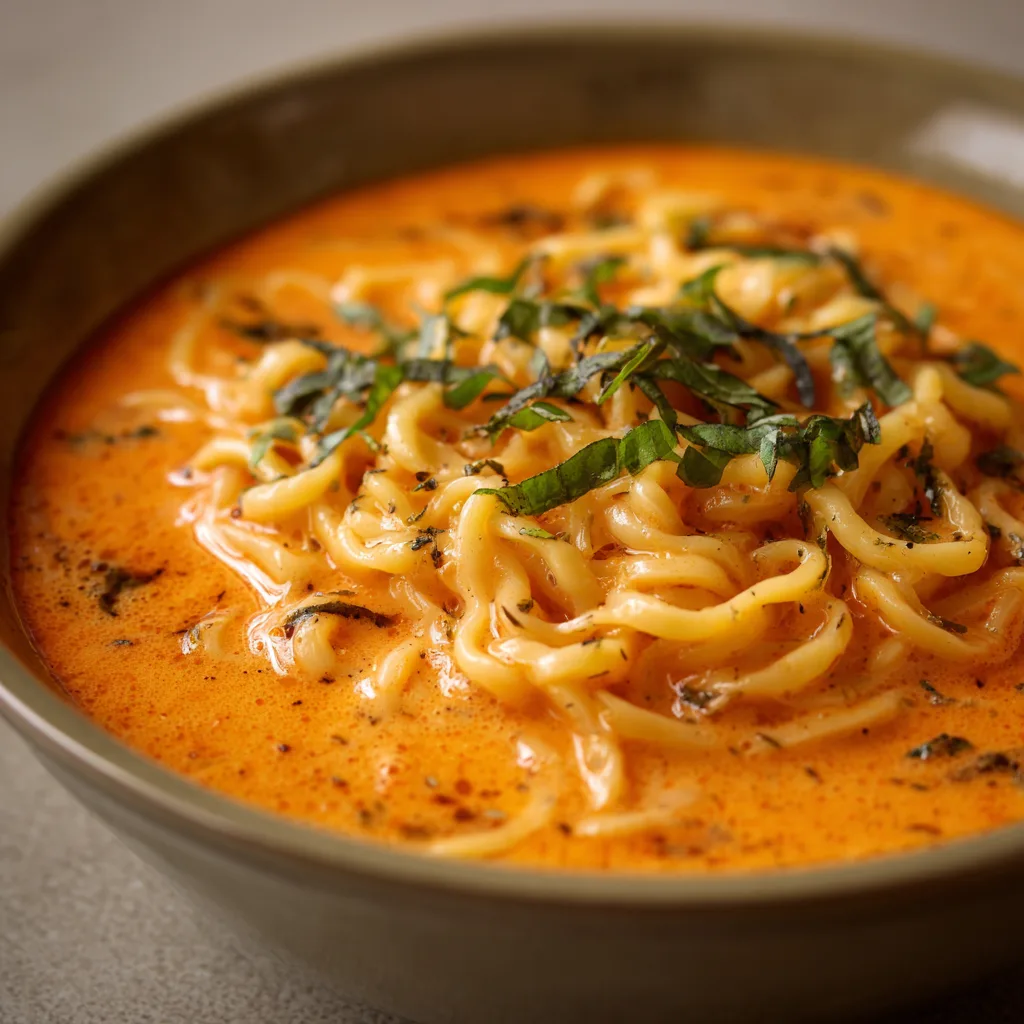Creamy Tomato Noodle Soup: A Comforting Classic
Creamy tomato noodle soup is a hug in a bowl. This comforting dish combines the bright acidity of tomatoes with the richness of cream and the satisfying texture of noodles. Perfect for a chilly day or a quick weeknight meal, this recipe is surprisingly versatile and easy to customize. Let’s dive into creating the perfect bowl of creamy tomato noodle soup.
The Foundation: Building Flavor
The base of any great soup is a flavorful broth. While you can use store-bought chicken or vegetable broth, making your own elevates the dish significantly. Roasting the vegetables before adding them to the broth intensifies their flavor.
Roasting the Vegetables: Toss diced onions, carrots, and celery with olive oil, salt, pepper, and a touch of garlic powder. Roast them at 400°F (200°C) for about 20-25 minutes, until softened and slightly caramelized.
Creating the Broth: In a large pot, combine the roasted vegetables with your chosen broth. Add a bay leaf, some thyme sprigs, and a Parmesan rind (if you have one) for extra depth. Simmer for at least 30 minutes to allow the flavors to meld. Remove the bay leaf, thyme, and Parmesan rind before proceeding.
Tomato Base: Use high-quality canned crushed tomatoes or diced tomatoes. Fire-roasted tomatoes add a smoky dimension that enhances the overall flavor. Add the tomatoes to the pot with the broth and vegetables. Simmer for another 15-20 minutes to allow the tomato flavor to fully develop. Consider adding a tablespoon of tomato paste at this stage to boost the umami and deepen the color.
Creamy Dream: Achieving the Perfect Texture
The key to creamy tomato noodle soup is achieving that luscious, velvety texture without making it too heavy. There are several ways to accomplish this.
Choosing Your Cream: Heavy cream provides the richest flavor and texture, but it can be quite decadent. For a lighter option, use half-and-half or even crème fraîche. A vegan alternative is coconut cream, which adds a subtle sweetness and creamy texture.
Adding the Cream: Gently stir in the cream of your choice during the last few minutes of cooking. Avoid boiling the soup after adding the cream, as it can cause it to curdle. Start with a smaller amount of cream and add more to reach your desired consistency.
Blending for Smoothness: For an extra-smooth texture, use an immersion blender to partially blend the soup before adding the cream. This will create a smoother base and help the cream incorporate more seamlessly. Be careful not to over-blend, as this can make the soup gummy. An alternative to an immersion blender is a regular blender. However, hot soup can create pressure inside a standard blender, so remove the center piece of the lid and cover with a towel to allow steam to escape, and blend in batches.
Alternative Creaminess: If you are dairy-free, or want to try a lighter option, you can use cashews for creaminess. Soak one cup of raw cashews in hot water for at least 30 minutes. Drain and blend them with one cup of fresh water until completely smooth. Add this to the soup in place of dairy cream.
Noodle Know-How: Selecting the Right Shape
The type of noodle you choose can significantly impact the overall experience of your creamy tomato noodle soup.
Small Noodles: Small pasta shapes like ditalini, orzo, or acini di pepe are excellent choices for a classic tomato noodle soup. They distribute evenly throughout the soup and provide a delicate texture.
Medium Noodles: Medium-sized noodles like elbow macaroni or small shells offer a heartier bite and hold the sauce well. These are good options if you prefer a more substantial soup.
Long Noodles: While less traditional, broken spaghetti or egg noodles can also be used. Be sure to break them into smaller pieces before adding them to the soup for easier eating.
Cooking the Noodles: Cook the noodles separately according to package directions until al dente. Adding the noodles directly to the soup can cause them to absorb too much liquid and become mushy. Drain the noodles and add them to the soup just before serving. This ensures that they retain their texture and don’t overcook.
Gluten-Free Options: Gluten-free pasta varieties are readily available, made from ingredients like rice, corn, or quinoa. Choose a gluten-free noodle that holds its shape well during cooking.
Customization is Key: Adding Your Personal Touch
One of the best things about creamy tomato noodle soup is its versatility. Feel free to experiment with different ingredients and flavors to create your own signature version.
Protein Power: Add cooked chicken, sausage, or chickpeas to make the soup more filling and satisfying. Shredded rotisserie chicken is a convenient option. If using sausage, brown it in a separate pan before adding it to the soup.
Vegetable Variety: Incorporate additional vegetables like spinach, kale, or zucchini. Add leafy greens during the last few minutes of cooking so they don’t become overcooked.
Herb Infusion: Fresh herbs like basil, oregano, or parsley add a burst of freshness. Stir them in at the end of cooking or use them as a garnish. A sprinkle of red pepper flakes can also add a subtle kick.
Spice it Up: A dash of hot sauce or a pinch of cayenne pepper can add some heat to your creamy tomato noodle soup. Taste and adjust the seasoning as needed.
Cheese, Please: Grated Parmesan cheese or a dollop of ricotta cheese can add extra richness and flavor. Sprinkle it on top of each bowl before serving. A grilled cheese sandwich served alongside is always a welcome addition.
Serving Suggestions & Storage
Creamy tomato noodle soup is best served hot, garnished with fresh herbs, a drizzle of olive oil, and a sprinkle of grated Parmesan cheese.
Serving Companions: Crusty bread or grilled cheese sandwiches are perfect accompaniments for dipping into the soup. A side salad adds a refreshing contrast to the rich and creamy soup.
Storage: Leftover soup can be stored in an airtight container in the refrigerator for up to 3 days. The noodles may absorb some of the liquid during storage, so you may need to add a little broth when reheating. Reheat gently over low heat, stirring occasionally. Freezing is not recommended, as the cream may separate during thawing. However, if you want to freeze it, omit the cream and noodles, then add these ingredients when reheating.
Reheating: Reheat the soup gently on the stovetop over medium-low heat, stirring frequently, until heated through. Avoid boiling the soup, as this can cause the cream to separate. Alternatively, you can microwave the soup in a microwave-safe bowl, stirring occasionally.
Presentation: A swirl of cream and a sprinkle of fresh herbs can elevate the presentation of your creamy tomato noodle soup. A crusty bread on the side for dipping makes it even better.
Frequently Asked Questions (FAQ)
Can I use fresh tomatoes instead of canned?
Yes, you can use fresh tomatoes. You will need about 2 pounds of fresh tomatoes. Peel, seed, and chop them before adding them to the soup. You may also need to add a teaspoon of sugar to balance the acidity.
How can I make this soup vegan?
To make this soup vegan, use vegetable broth, coconut cream, and gluten-free noodles. You can also use cashew cream or other plant-based cream alternatives. Omit the Parmesan rind when making the broth.
Can I add other vegetables to this soup?
Yes, you can add other vegetables such as spinach, kale, zucchini, or bell peppers. Add them during the last few minutes of cooking so they don’t become overcooked.
How do I prevent the cream from curdling?
To prevent the cream from curdling, gently stir it in during the last few minutes of cooking and avoid boiling the soup after adding the cream.
Can I freeze this soup?
Freezing is not recommended, as the cream may separate during thawing. If you want to freeze it, omit the cream and noodles, then add these ingredients when reheating.
What kind of noodles are best for this soup?
Small pasta shapes like ditalini, orzo, or acini di pepe are excellent choices for a classic tomato noodle soup. Medium-sized noodles like elbow macaroni or small shells offer a heartier bite.
How do I thicken the soup if it’s too thin?
If the soup is too thin, you can simmer it uncovered for a longer period to allow some of the liquid to evaporate. You can also add a cornstarch slurry (1 tablespoon of cornstarch mixed with 2 tablespoons of cold water) to thicken it.
How do I thin the soup if it’s too thick?
If the soup is too thick, add more broth or water until you reach your desired consistency.
What can I serve with creamy tomato noodle soup?
Crusty bread, grilled cheese sandwiches, or a side salad are perfect accompaniments for dipping into the soup.
How do I make this soup gluten-free?
Use gluten-free noodles made from ingredients like rice, corn, or quinoa.




